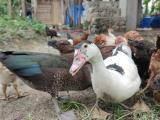Dec 21, 2007 (CIDRAP News) – The World Health Organization (WHO) said today there has been no evidence of more cases of H5N1 avian influenza in the wake of a recent case cluster in Pakistan, as news services reported at least five suspected H5N1 cases in an Indonesian family.
WHO officials in Geneva said no more H5N1 cases have been identified in the area of Abbotabad in northern Pakistan, where the cluster was reported last weekend. Results of confirmatory tests in the eight cases are still awaited, they told CIDRAP News.
Keiji Fukuda, coordinator of the WHO's global influenza program, told Reuters this week that the Pakistan cases probably represent a mix of poultry-to-human infections and human-to-human transmission resulting from close contact when people cared for infected relatives.
"We don't have any indication of a broader health threat, other than poultry outbreaks" in the area, WHO spokesman John Rainford told CIDRAP news today. "Our risk assessment suggests no evidence of sustained transmission. All the close contacts and involved healthcare workers remain asymptomatic and have been released from close medical observation."
The WHO sent a team of experts to Pakistan to help investigate the situation, and US Navy Medical Research Unit 3 (NAMRU-3) in Cairo has sent a portable laboratory.
Rainford declined to predict today how soon confirmatory testing in the eight cases, which were identified in preliminary tests by Pakistan's national lab, will be completed. He said some samples from the patients would be sent to London for analysis.
"I hope we'll get some early results but question whether we'll have lab results that are what we need," he said. "We've got, hopefully, samples arriving in London sometime over the weekend that will provide a better environment to assess what we've got."
He said he expected both the NAMRU lab and the one in London will play a role in the testing: "NAMRU staff on site will be able to give us some information, but I guess there's a role for an additional lab to give us a full picture."
The patients who tested positive include four brothers in one family, one of their cousins, and two other people, according to news reports. The family group was originally described as four brothers and two cousins, but one patient initially identified as a cousin was actually a brother, the Associated Press reported on Dec 21. One of the four brothers died, and a fifth brother also was suspected of having the disease but died without being tested. The other three people were described as a man and his niece who were involved in culling poultry in connection with avian flu outbreaks, and a male farm worker from another town nearby.
WHO spokesman Gregory Hartl told CIDRAP News today that all of the surviving case-patients have recovered, adding, "I believe that all of them have also been released from hospital."
Meanwhile, five members of a family from Indonesia's West Java province have been hospitalized with suspected H5N1 cases, according to news reports citing Indonesia's state news agency, Antara, as their source.
A man named Fathurahman told Antara that his three children, aged 8, 10, and 16, suffered from high fevers, coughing, and breathing difficulty after an H5N1 outbreak among local poultry, according to a report by the Straits Times, a Singapore newspaper.
The three children and two other people in their extended family—siblings aged 17 and 30—were hospitalized in Serang, about 80 kilometers west of Jakarta, early this week, the story said. They were transferred today to Persahabatan Hospital in Jakarta, which is designated to treat avian flu patients, the report said.
A Xinhua report today said avain flu was suspected in the patients after health officials learned that 60 chickens and ducks in their village had died of H5N1 disease.
Two more members of the same family have also had symptoms suggesting avian flu but have not been hospitalized, the Straits Times reported.
In other developments, WHO officials said they will never know whether the recent H5N1 cases in a son and father in China involved person-to-person transmission. The patients were a 24-year-old man who died Nov 27 and his father, who was hospitalized with an H5N1 infection 6 days later.
David Heymann, the WHO's assistant director-general for communicable diseases, said today that the possibility of person-to-person transmission can never be confirmed or excluded, because the father and son had a common environmental exposure, Hartl told CIDRAP News.
Hong Kong newspapers reported earlier this month that before falling ill, the two men had both eaten undercooked chicken at a restaurant in Nanjing, capital of Jiangsu province.
See also:
Dec 17 CIDRAP News story "Possible H5N1 family cluster probed in Pakistan"
Dec 10 CIDRAP News story "Reports suggest common source in family H5N1 cases"



















